Can’t you find the way to add labels to data points in the scatter chart in Google Sheets? I have the answer.
You can annotate data points in the Scatter chart in Google Sheets. If you want to know how to plot a Scatter chart, then first see my related tutorial below.
Related: How to plot the Scatter chart in Google Sheets.
The above tutorial has all the necessary info related to Scatter Plot. I suggest you read that post first.
Here I am more concentrating on the Data Point Labels in Scatter Graph though I have included how to plot Scatter in a limited way.
Hope you are back. Good! Now let us see how to annotate data points in the Scatter chart.
How to Add Labels to Data Points in Scatter Chart in Google Sheets – Annotated Scatter Chart
Unlike some other charts like the Timeline, when it comes to Scatter, Google Sheets offers enough customization options.
One of the roadblocks for me to create a sample Scatter chart with labels was the lack of suitable data. But I have managed to prepare some realistic data for you.
First I am attempting with demo data which is not realistic. I am sure it will be enough for you to understand how to add labels to data points in the Scatter Chart.
After learning this, you can go to my real-life example to Google Sheets popular Scatter Charts. I have included that at the end part of this tutorial.
Sample Data:
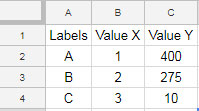
Follow the step by step instruction below to annotate data points in the Scatter Chart.
Scatter Chart with Labels in Google Sheets – Step by Step Instructions with Demo Data
Please consider the above three-column data as our source data for the chart.
Steps to Follow:
1. Select the data range B1:C4. Yes, I am skipping column A, I mean the range A1:A4.
2. Go to Insert > Chart. Google Sheets will plot a default chart, probably a column chart.
3. Select Scatter.
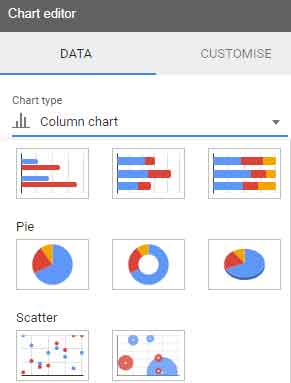
4. Your Scatter Chart will look like as below. Then the next step is to add data labels to the Scatter chart.
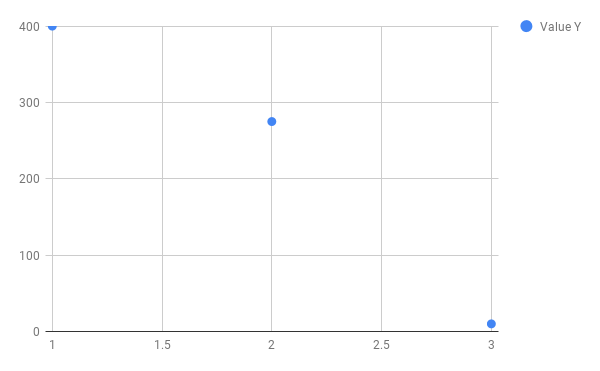
This chart looks bald right? Just add the labels and adjust the horizontal and vertical axis scale to make it a better one. See that below.
5. To add data point labels to Scatter chart in Google Sheets, do as follows.
Under the DATA tab, against SERIES, click the three vertical dots. Then select “Add Labels” and select the range A1:A4 that contains our data point labels for the Scatter.
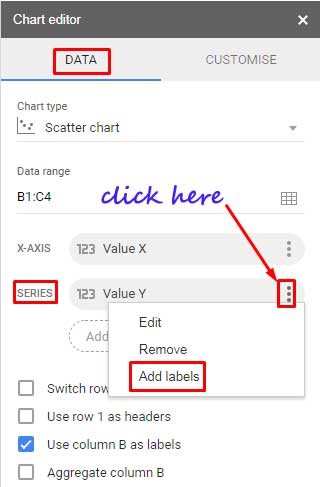
Here some of you may face issues like seeing a default label added. In that case, after clicking “Add labels” follow the below points.
You may happen to see “Value X” or “Value Y” automatically added as data point labels. Click on it and select the range A1:A4. This GIF may help you to understand this step.
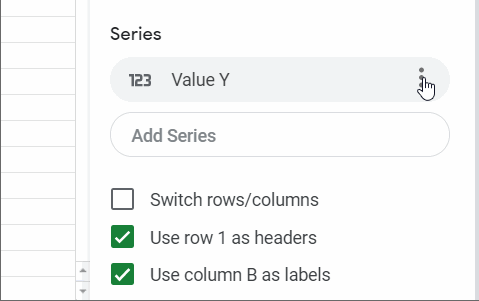
That’s all. Our Scatter chart with data point labels is ready.
Additional Points That You Should Take Care Of
One important point. Do check the CUSTOMISE tab option that saying “treat labels as text” that under the “Horizontal axis” is unchecked.
Look for the same option under the “Vertical axis” too and uncheck there also.
This option may or may not exist. So don’t worry if you don’t find the option to uncheck. It depends on other settings.
Then if you want you can customize the Min and Max values of the Horizontal and Vertical Axis to make the data points well cover within the chart.
This you can find just below the above said uncheck options.
The easiest way to access this is to double click on the horizontal/vertical axis values on the Chart itself. This will directly take you to the said options in the CUSTOMISE tab.
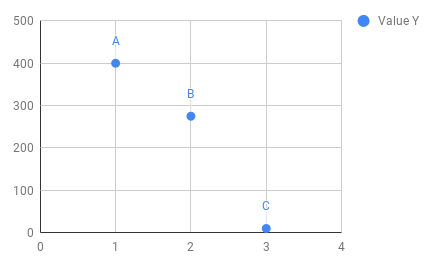
This proves that you can add data labels to a Scatter chart in Google Sheets. Now here is one real-life example.
The following chart is based on the source data from this Wiki page. I have taken only part of the data for the chart purpose.
Visit the source for detailed information on the content/statistics.
Real-Life Example to Annotated Scatter Chart in Google Sheets
I have the new sample data in the range A1:C7 which shows the average weight of people around the world.
The chart on the right-hand side of this data is prepared as per the instructions which I have given above.
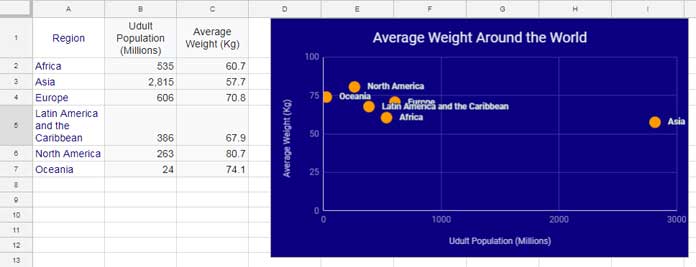
Here I have done some additional customization. What are they?
I have arranged the data labels on the right side of the data points. Further, the data point color is changed.
You can change the size, color, and even shape of the data points and alignment of the text of the label from the CUSTOMISE tab of the chart editor. Here is how.
Must Check: Common Errors That You May Face in Scatter Chart in Google Sheets.
How to Customize Data Points in the Scatter Chart
Steps:
Under the Series select the series “Average Weight (Kg) which is the Y-axis values.
There you can see the above customization options.
That’s all about adding data point labels in Google Sheets Scatter Chart. Enjoy!
Related:
1. Create a Gantt Chart Using Sparkline in Google Sheets.






















Thank you!
Great tutorial as always. One question, though. How do you handle overlapping data labels? Say you have a few dots next to each other. How do you make it “readable”?
Hi, Arta,
I don’t find a way to do that with the available chart settings.
It seems the Bubble chart doesn’t have that issue. So try it.
I can not get this to work. I never seem to get an option to select the labels from a different column.
Do you know of a way to make the labels hover-only – when there are a lot of points it’s hard to see anything…
Hi, Julia,
Use Bubble chart. You can make the bubbles smaller similar to Scatter.
Inside my tutorial, Conditional Coloring Data Points in the Scatter Plot In Google Sheets, in the end, you can see a link to my sample sheet.
Copy that sheet. In that sheet, check the tab “bubble” for an example.
Hi,
This is currently driving me insane… I am trying to simply label the scatter plot values. When I click on series–> data labels –> the only option is type: value which is the y-axis, no way to customize. any ideas?
Many thanks,
Julia
Hi, Julia,
Sorry for making the confusion. I have just edited the post to include a new GIF image to make you understand the step clearly.
Actually, you are seeing the default labels added. You should click on it to select your required labels’ range.
Anyway to make replace the hover labels instead of an always-visible label?
Thank you! It was very helpful!
Thanks. I was pulling my hair out trying to figure out how to add labels! This was perfect.